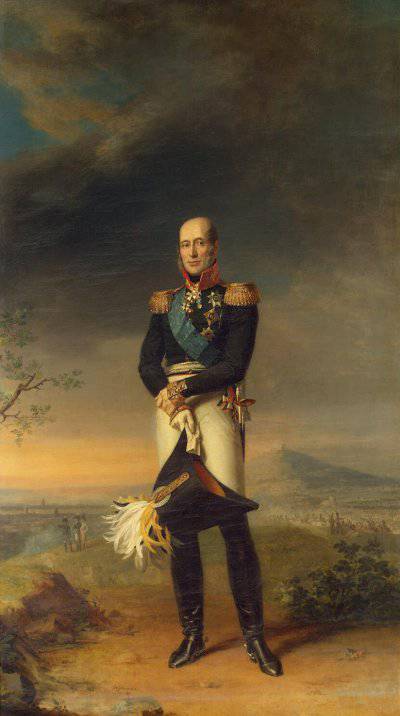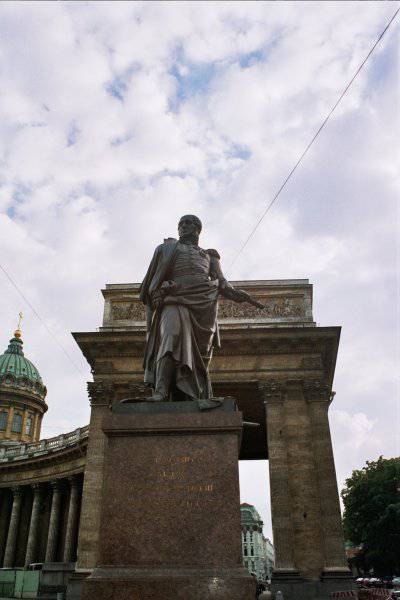Mikhail Bogdanovich Barclay de Tolly
 More Napoleon Bonaparte annoyed at the impossibility of shooting public opinion from the guns. But not only the French emperor was forced to reckon with public opinion. In Russia, his pressure was in no way inferior to post-revolutionary France. Mikhail Bogdanovich Barclay de Tolly was a frequent target of undeserved criticism of court circles in the difficult period of the Patriotic War 1812 year.
More Napoleon Bonaparte annoyed at the impossibility of shooting public opinion from the guns. But not only the French emperor was forced to reckon with public opinion. In Russia, his pressure was in no way inferior to post-revolutionary France. Mikhail Bogdanovich Barclay de Tolly was a frequent target of undeserved criticism of court circles in the difficult period of the Patriotic War 1812 year.Mikhail Bogdanovich (Michael Andreas) was born in December 1761 of the year in the German Hanseatic family of de Tolly - a branch of the old Scottish family Barclay. The father of Field Marshal Weingold Gotthard (adopted the Slavic name Bogdan) Barclay de Tolly joined the Russian service in the middle of the century and retired with the rank of lieutenant, earning a nobility.
From the age of three, Michael-Andreas was raised in the family of his uncle Georg Wilhelm von Vermelen. At that moment he commanded the Novotroitsk Cuirassier Regiment, where Mikhail Bogdanovich was enrolled from the age of ten. The actual service began, as was customary, in 15 years with the rank of sergeant of the Pskov Carabinieri Regiment. Only in 8 years did Barclay de Tolly receive the first officer rank - the rank of cornet - which affected the ignoble origin.
In 1783, a capable officer was noticed by General von Patkul and took his adjutant up to second lieutenant. Through 3, Barclay de Tolly, with the rank of lieutenant, is transferred to the 1 battalion of the Finnish Jaeger Regiment to Count F. E. Anhalt. A year later, Mikhail Bogdanovich received a baptism of fire in the Russian-Turkish war (1787-1791). Barclay de Tolly participated in the assault on Ochakov in 1788, then in the battle of Causen, taking Bender and Ackermann. In the service advanced to the seconds-major. Until the end of the war with the Turks, in 1790, Barclay de Tolly was transferred to the Finnish army, in which he took part in the final stage of the war with Sweden, 1788-1790. Mikhail Bogdanovich distinguished himself in the battle of Pardakoski, for which he was granted the rank of prime minister. A few months later he was appointed commander of the battalion of the St. Petersburg Grenadier Regiment.
In 1794, Mikhail Bogdanovich participated in the suppression of the Kosciuszko uprising in Poland. Here he proved himself to be an excellent tactician, being forced to act against small and isolated rebel detachments. For these successes, as well as for the capture of the city of Vilna, Barclay de Tolly received the Order of St.. George 4 degree, and after a few months followed by an increase to lieutenant colonel. At the end of 1794, Mikhail Bogdanovich was transferred to the Estonian Chasseurs Corps by the battalion commander. In 1798, Barclay de Tolly receives the rank of colonel, and next year he heads the rangers' regiment, renamed from Estland to 4.
The confused reign of Paul I with his disgraces on talented generals and those close to Ekaterina did not touch Mikhail Bogdanovich. The ignoble origin and remoteness from Petersburg and its intrigues, which so long hindered the career development of a talented officer, in this case played in his favor.
In Colonels Barclay de Tolly did not stay long, his leadership abilities were demonstrated to the post of the regiment's chief. In March, 1799, for excellent training of soldiers, he receives the rank of major general. It should be noted that the huntsmen are special infantry, they had to operate in hard-to-reach places, such as mountains, forests or difficult terrain. In short, wherever it was impossible to build a standard line infantry. The Rangers had to shoot straight, be different in stamina, move quickly and quietly on the ground and, of course, be able to stand up for themselves in bayonet fighting. The soldiers of Barclay de Tolly met these requirements completely.
With the French troops, Mikhail Bogdanovich encountered for the first time in the battle of Austerlitz. Already in this battle it became clear to him how dangerous Napoleon could be. In the 1806-1807 campaign, Barclay de Tolly led the division and in the first major battle of Pultusk, commanding the first line, repelled all the attacks of Marshal Lannes. For this battle he received the Order of St.. George 3 degree.
Covering the retreat of the Russian army through the city of Preussisch-Eylau, Mikhail Bogdanovich was seriously wounded in his right hand. Rana has long made itself felt. For several years he had to wear a broken arm in a sling. Barclay de Tolly has even formed the habit of holding his right hand with a healthy left. Appreciating the rearguard battle at Preussis-Eylau, Mikhail Bogdanovich was fired as lieutenant general.
Because of the injuries, Barclay de Tolly was forced to be removed from the army for a long time for treatment and returned to the troops only to the war with Sweden 1808-1809 of the year. Here, fulfilling the will of the emperor, Barclay and his troops made the most difficult transition on the ice of the frozen Kvarken Strait and occupied the Swedish city of Umeå. This maneuver forced Sweden to enter into negotiations, they ended, however, the resumption of hostilities. By the end of the war, Barclay led the troops of all of Finland and received the rank of general from the infantry.
Alexander did not ignore the talent and skills of Barclay de Tolly. In January, 1810, Mikhail Bogdanovich was appointed to the post of Minister of War in the position of a high-level military officer on the eve of the war with Napoleon. Barclay certainly understood how much would be at stake in the upcoming clash. Without losing time, he actively takes up the reform of the army. The past wars showed the superiority of corps organization and tactics of attacking columns, which was first used by Suvorov.
The first direction of reform is the regulation of actions of commanders in combat conditions and in the training of soldiers, as well as the precise definition of the hierarchy of ranks and the range of duties that corresponds to them. The result of the hard work of the commissions was the "Establishment for managing a large active army" - one of the most advanced documents in Europe at that time. Thanks to the efforts of Barclay de Tolly, the size of the army was doubled, the supply was improved. As part of preparations for war, warehouses were organized. weapons and food stores, a supply network, fortresses were repaired. A lot of work was done to improve the artillery park. Under Barclay, the introduction of the “Arakcheev” or “1805 of the Year” system was completed, which provided for the unification of artillery and the transition to uniform principles for the production and supply of all guns in the army.
In addition, under the leadership of Mikhail Bogdanovich, a strategic deviation plan was developed, but its initial version, which provided for a retreat before the Volga, was not adopted by Alexander. Later, General Pfuhl (or Ful) proposed a plan of withdrawal to the Driss fortified camp, with the simultaneous operation of armies in the flanks and rear of the French. When the war began, it became impossible to carry it out, since very few people thought that Napoleon would be able to gather and feed a half-million horde and move against each of the three Russian armies superior troops.
Having retreated with battles to a useless but fortified camp, Barclay de Tolly decides to unite with the army of Bagration near Vitebsk, but not having had time to go to the city before Napoleon, transfer the gathering place to Smolensk.
The assault on Smolensk was the first major battle of the 1812 campaign of the year. The well-known military historian von Clausewitz noted that Barclay managed to turn the battle for Smolensk from general into meaningless from a strategic point of view for the French. The Great Army suffered significant losses, without having a chance to inflict an unconditional defeat on the Russians.
 Public opinion, meanwhile, was actively expressing dissatisfaction through home-grown court "strategists". The army in grumbling did not lag behind, even Bagration wrote angry letters to the emperor, accusing Barclay of treason. Pouring oil on the fire and non-Russian origin of Mikhail Bogdanovich. August 29 Alexander, having conceded to the requirements of the “public”, appoints Kutuzov commander-in-chief. The High Prince clearly understood and supported the strategy of Mikhail Bogdanovich, but at the same time possessed absolute authority in the army and nobility circles. This allowed Kutuzov to bring Barclay de Tolly’s strategy to a logical conclusion.
Public opinion, meanwhile, was actively expressing dissatisfaction through home-grown court "strategists". The army in grumbling did not lag behind, even Bagration wrote angry letters to the emperor, accusing Barclay of treason. Pouring oil on the fire and non-Russian origin of Mikhail Bogdanovich. August 29 Alexander, having conceded to the requirements of the “public”, appoints Kutuzov commander-in-chief. The High Prince clearly understood and supported the strategy of Mikhail Bogdanovich, but at the same time possessed absolute authority in the army and nobility circles. This allowed Kutuzov to bring Barclay de Tolly’s strategy to a logical conclusion. Under Borodino, the commander of the 1 Army Michael Barclay de Tolly appeared in the most dangerous places. In the morning, after Rayevsky's battery was returned by General Yermolov’s counterattack, Barclay, without waiting for a request from Alexey Petrovich, strengthened his position with infantry and artillery from his own reserve. During the battle of Barclay de Tolly, 11 horses were killed and wounded. For Borodino, the commander of the 5 Army received the Order of St.. George 1 degree.
After the battle of Borodino and the reorganization of the army, he takes a vacation and goes to his village in Livonia. In the army, Barclay de Tolly returned only with the beginning of the foreign campaign.
In the 1812-1814 campaign, Mikhail Bogdanovich commanded the 3 Army, then by combined Russian-Prussian troops and distinguished himself in many battles. So, for the victory at Kulm, he received the order of St.. George 1 degree, becoming one of the few full gentlemen of this award. Later, in the Battle of the Nations under Leipzig played a significant role in the victory of the Allies. In the 1814 year, after the capture of Paris, he was promoted to field marshal, and a year later he was elevated to princely dignity.
After the end of the Napoleonic wars, Barclay de Tolly led some time the 1 th army, stationed in Poland, but was forced to resign due to sharply deteriorating health.
In 1818, the road to the place of treatment on mineral waters, the field marshal died. Buried Mikhail Bogdanovich Barclay de Tolly in the family estate Bekgof (now the territory of Estonia).
Barclay de Tolly rightfully enters the galaxy of brilliant Russian generals who glorified Russian weapons and defended the country from the French invasion.
Information